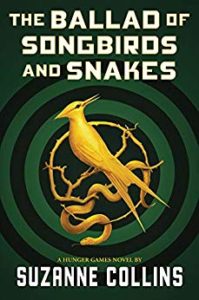When I first heard they were doing The Ballad of Songbirds and Snakes, a Hunger Games prequel, last year, I was only mildly interested. Sure, I went to see all the movies, and it was one of the book series I’ve read in both Spanish and English, but it’s been at least 5 years since I’ve read it. Do I want to go back to the world? It turns out, the book was pretty good and now I want to reread The Hunger Games at some point.
The book centers on Coriolanus Snow, which, if you’ve read The Hunger Games, is an antagonist from the series. How is this book going to work out, making him likable? We’re all the heroes of our own stories, I guess. It turns out, I was pleasantly surprised.
What I Liked
What I liked most about The Ballad of Songbirds and Snakes was how it gives so much backstory into the original The Hunger Games trilogy. When we’re first dumped into the 74th annual Hunger Games, the capital has everything down already. They’re exciting (if not gruesome) to watch, there’s stakes for all the districts involved, and sometimes people actually volunteer for these things. The victors are rewarded! The 10th Hunger Games–not so much. They’re still figuring these things out. We get to see how these things are put into motion.
Then there’s “The Hanging Tree.” People have been talking about the origins to this song for years, wondering where it came from. It’s stuck with me for years, and I remember the tune still. We get to find out the story behind this song. I love it when book series tie into each other across a character’s universe (maybe that’s why I like shadowhunters books so much). There is so much here that brings Panem to life. It’s great.
Then there’s the story itself. Coriolanus is a sympathetic character–for most of the book. This is not the capital we’re used to, full of wealthy, privileged, and clueless citizens. While it is true they’re better off than everybody in the districts, Panem is only 10 years away from a devastating war. I have a German textbook written in the late 1970s, and from the impression I get from that book, they were still recovering from World War II (the infrastructure was so bad that telephone calls were a luxury). I found myself rooting for him throughout the book. He’s a mentor for the 10th Hunger Games, and gets assigned to the girl from District 12.
He’s thrown a lot of challenges and he has to overcome them. At the same time, despite his challenges, you see the ambition that eventually turns him into President Snow. His mentee is a great character as well, and you want to root for her too.
What I Liked Less
While I can’t say there was anything I disliked about The Ballad of Songbirds and Snakes, there was a part that surprised me. After the Hunger Games end, there’s still a third of the book left. What? Initially, it felt like the story should have ended there. However, the last third of the book shows us how Coriolanus Snow turns from a sympathetic character to being set on the path that leads him to becoming the villainous President Snow 64 years later. It also contains the origin to the song “The Hanging Tree,” which I really enjoyed.
Conclusion
The Ballad of Songbirds and Snakes is an enjoyable story that gives us a lot of background into The Hunger Games. I want to go on and reread the original series now. There were times I didn’t want to put it down. I definitely recommend it if you liked the original series.
